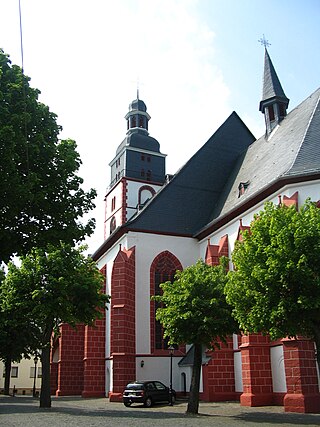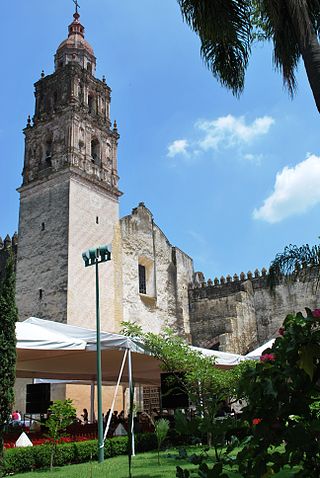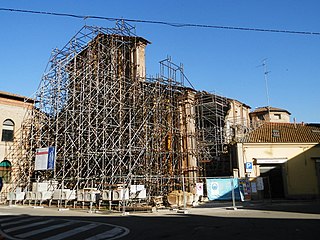



The hospital-church (Spitalkirche) Holy Spirit in Pfaffenhofen an der Ilm is the church and hospice of the erstwhile Franciscan Monks. It is located near the upper side of the main square, opposite the parish church of St John the Baptist.




The hospital-church (Spitalkirche) Holy Spirit in Pfaffenhofen an der Ilm is the church and hospice of the erstwhile Franciscan Monks. It is located near the upper side of the main square, opposite the parish church of St John the Baptist.
In 1703 the Franciscans built a hospice on the upper side of the main square in Pfaffenhofen. The monastery and church was built between 1716 and 1719 in the baroque style by an unknown architect. Below the choir of the church is a crypt, which was used to store grain and ammunition during the Coalition Wars. The monastery was dissolved in 1802 as part of the secularisation of Bavaria. The town of Pfaffenhofen acquired the site and set up the municipal hospital, which had previously stood on the site of the present-day town hall. The church served as a place of worship for the patients of the hospital. In 1900 the derelict north tower was demolished and a new tower was erected on the south façade, in accordance with Johann Baptist Schott's architectural plans. In 1959 the arcade porch of the southern side of the building was built and in 1974 the church received a new organ. [1]
Latterly the municipal building complex served as a retirement home until 1997, when this was shut down. The residents at the time were relocated to premises outside of the town centre, which were the site of the municipal hospital from 1862 to 1984. [2] In 2015 the church was renovated for €725,000. During the eight-month construction period the roof truss was secured and a new coat of paint was applied to the façade. [3] Today the church is used for worship, weddings and concerts. During Advent and Christmastime a magnificent nativity scene is displayed, some of whose figurines are more than 200 years old. The crib, which is altered many times between the first day of Advent and Candlemas, is part of the Pfaffenhofen Krippenweg. [1]
The hospital church is a plastered aisleless church with a choir and side chapel on the western side. It is not - as was typical for buildings at the time - oriented towards the east; instead the choir is on the northern side. The nave and the choir gallery are vaulted with a barrel vault. On the southern front gable, there is a neo-Baroque, octagonal tower with an onion dome.
The majority of the church's furnishings date from the time the church was built. The altar panels of all of the four altars were created by the electoral court painter Johann Caspar Sing from Munich. The main altar painting depicts the Holy Kinship, Jesus Christ surrounded by his relatives. Up to the beginning of the 19th century, the interior of the church was also decorated by ceiling paintings by the famous artist, Cosmas Damian Asam. Today's ceiling frescoes are Michael P. Weingartner's work from 1952. They show various scenes of the life of Francis of Assisi. The church's Stations of the Cross date from 1862. The war memorial is situated under the archways that surround the church. The accompanying mosaics, like the ceiling paintings, are also by Michael P. Weingartner. [1]
The former monastery buildings, in which a hospital and a retirement home were later located, are directly adjoined to the east side of the church. The double-layered, plastered mono-pitched roof originates, in part, from the 18th century.
Jolanda Drexler-Herold, Angelika Wegener-Hüssen: Landkreis Pfaffenhofen a. d. Ilm (= Bavarian State Office for Monument Protection [publisher]: Denkmäler in Bayern. Vol. I.19). Karl M. Lipp Verlag, Munich 1992, ISBN 3-87490-570-5, p. 158.

Zell (Mosel) is a town in the Cochem-Zell district in Rhineland-Palatinate, Germany. Zell has roughly 4,300 inhabitants and is the seat of the like-named Verbandsgemeinde.

The Franciscan missions of the Sierra Gorda of Querétaro are five missions built in Mexico between 1750 and 1760. The foundation of the missions is attributed to Junípero Serra, who also founded the most important missions in California. They were declared a World Heritage Site by UNESCO in 2003.

St. Catherine's Church is the largest Protestant church in Frankfurt am Main, Germany. It is a parish church in the old city centre near one of the most famous city squares, the Hauptwache. The church is dedicated to the martyred early Christian saint Catherine of Alexandria.

Sankt Aldegund is an Ortsgemeinde – a municipality belonging to a Verbandsgemeinde, a kind of collective municipality – in the Cochem-Zell district in Rhineland-Palatinate, Germany. It belongs to the Verbandsgemeinde of Zell, whose seat is in the municipality of Zell an der Mosel. Sankt Aldegund is a winegrowing and holidaymaking centre.

Kirchberg, the Stadt auf dem Berg, called Kerbrich in Moselle Franconian, is a town in the Rhein-Hunsrück-Kreis (district) in Rhineland-Palatinate, Germany. It is the seat of the like-named Verbandsgemeinde, to which it also belongs.

Lubiąż Abbey is a former Cistercian monastery in Lubiąż, in the Lower Silesian Voivodeship of southwestern Poland, located about 54 km (34 mi) northwest of Wrocław. The monastery is considered to be one of the largest of its kind with a 223 m long main facade.

The Franciscan Church of the Annunciation is a Franciscan church located on Prešeren Square in Ljubljana, the capital of Slovenia. It is the parish church of Ljubljana - Annunciation Parish. It was built on a site where two or possibly three churches stood earlier between 1646 and 1660 under the management of Francesco Olivieri and Francesco Rosina, and its exterior was redesigned in 1858 according to plans by Franz Kurz zum Thurn und Goldenstein. The frescoes in the interior were added in the mid-19th century by Matevž Langus and on the ceiling by Matej Sternen in the first half of the 20th century, whereas the main altar was mostly made by the Baroque sculptor Francesco Robba (1736). The red or pink colour of the church is symbolic of the Franciscan monastic order. Since 2008, the church has been protected as a cultural monument of national significance of Slovenia.

Santa Maria di Canepanova is a Renaissance-style Roman Catholic church located in central Pavia, region of Lombardy, Italy. Although in the past the design was popularly attributed to Bramante, the church was designed by Giovanni Antonio Amadeo.

Michaelsberg Abbey or Michelsberg Abbey, also St. Michael's Abbey, Bamberg is a former Benedictine monastery in Bamberg in Bavaria, Germany. After its dissolution in 1803 the buildings were used for the almshouse Vereinigtes Katharinen- und Elisabethen-Spital, which is still there as a retirement home. The former abbey church remains in use as the Michaelskirche.

The Church of Saint John of Jerusalem outside the walls is a Roman Catholic parish church in the city of Poznań in western Poland. The original church on this site was built at the end of the 11th century, making it one of the oldest churches within the present boundaries of Poznań.

The Cuernavaca Cathedral is the Roman Catholic church of the Diocese of Cuernavaca, located in the city of Cuernavaca, Morelos, Mexico. The church and its surrounding monastery is one of the early 16th century monasteries in the vicinity of the Popocatepetl volcano inscribed as a World Heritage Site by UNESCO, built initially for evangelization efforts of indigenous people after the Spanish conquest of the Aztec Empire. By the 18th century, the church of the monastery began to function as the parish church of the city and in the late 19th century, it was elevated to the rank of a cathedral. Unlike many cathedrals in Mexico, this one does not face the city's main square, but rather is located just to the south, in its own walled compound, which it shares with a number of other structures. Unlike the other monastery structures from its time, the importance of this church provoked a number of renovation projects, the last of which occurred in 1957. This one took out the remaining older decorations of the interior and replaced them with simple modern ones. This renovation work also uncovered a 17th-century mural that covers 400 square metres (4,300 sq ft) of the interior walls and narrates the story of Philip of Jesus and twenty three other missionaries who were crucified in Japan.

The Franciscan Church is one of the oldest churches in Salzburg, Austria. The church is located at the intersection of Franziskanergasse and Sigmund-Haffner-Gasse opposite the Franciscan Friary in the Altstadt section of the city. The first church on this site was erected in the eighth century. Between 1408 and 1450, a Gothic choir replaced the Romanesque choir. A slender Gothic tower was added between 1468 and 1498. The church was dedicated to the Virgin Mary and served as the parish church until 1635. It was ceded to the Franciscan Order in 1642. Johann Bernhard Fischer von Erlach redesigned the church interior in the baroque style in the eighteenth century.

The Church of the Poor Clares dedicated to Assumption of the Blessed Virgin Mary is an historical church in Gdańska Street, Bydgoszcz, Poland.

Kloster Engelberg is a Franciscan monastery in Grossheubach in Bavaria, Germany. In the past, a pilgrimage dedicated to a figure of Mary, documented as far back as 1406, was administered by the Capuchins after 1630. Following secularization in the early 19th century, the Capuchins eventually left and the Franciscan order took over the abbey and caring for the pilgrims. The abbey is (partially) open to the public.

Ognissanti is a 16th-century Roman Catholic church located in the Dorsoduro sestiere of the Italian city of Venice.

The Parish Church of Our Lady of Purification is an 18th-century Roman Catholic church located in Santo Amaro, Bahia, Brazil. The church is dedicated to Blessed Virgin Mary and belongs to the Roman Catholic Archdiocese of São Salvador da Bahia. Its construction is dated to 1706. The church was listed as a historic structure by the National Historic and Artistic Heritage Institute in 1958.

The church of San Francesco is a church located in Mirandola, in the province of Modena, Italy.

The Oberkirche in the Thuringian town of Arnstadt, Germany, is a former Franciscan monastery church mainly built in the 13th century. Since 1538, it has been used by the Lutheran parish of Arnstadt, which today belongs to the Arnstadt-Ilmenau church district of the Protestant Church in Central Germany. It is a listed building.

The Barfüßerkirche in the historical city centre of Erfurt in Thuringia, Germany, belonged to the most important church buildings of the city and was one of the most elaborate mendicant churches in Germany until its extensive destruction by bombing in 1944. It was mainly built in the 14th century as a monastery church of the Franciscans, who were also called Barfüßer. The choir was restored in the 1950s; beside the nave's ruin, it is situated west of the Schlösserbrücke bridge on the right bank of the Breitstrom, a branch of the Gera river.

Fürstenzell Abbey is a former Cistercian abbey in Fürstenzell, in Bavaria, in the diocese of Passau. It was a daughter monastery of the Aldersbach monastery from the filiation of the Morimond primary abbey - Ebrach monastery.
48°31′49″N11°30′19″E / 48.53028°N 11.50528°E
This article needs additional or more specific categories .(March 2024) |